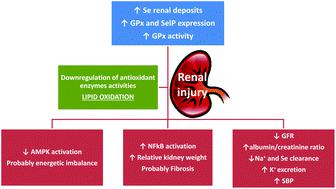当前位置:
X-MOL 学术
›
Food Funct.
›
论文详情
Our official English website, www.x-mol.net, welcomes your feedback! (Note: you will need to create a separate account there.)
Selenoproteins and renal programming in metabolic syndrome-exposed rat offspring.
Food & Function ( IF 6.1 ) Pub Date : 2020-03-26 , DOI: 10.1039/d0fo00264j María Luisa Ojeda 1 , Fátima Nogales , Alejandra Serrano , María Luisa Murillo , Olimpia Carreras
Food & Function ( IF 6.1 ) Pub Date : 2020-03-26 , DOI: 10.1039/d0fo00264j María Luisa Ojeda 1 , Fátima Nogales , Alejandra Serrano , María Luisa Murillo , Olimpia Carreras
Affiliation

|
Maternal metabolic syndrome (MS) during gestation and lactation leads to several cardiometabolic changes related to selenium (Se) status and selenoprotein expression in offspring. However, little is known about kidney programming and antioxidant selenoprotein status in MS pups. To gain more knowledge on this subject, two experimental groups of dam rats were used: Control (Se: 0.1 ppm) and MS (fructose 65% and Se: 0.1 ppm). At the end of lactation, Se deposits in kidneys, selenoprotein expression (GPx1, GPx3, GPx4 and selenoprotein P), oxidative balance and AMP-activated protein kinase (AMPK) and activated transcriptional factor NF-κB expression were measured. Kidney functional parameters, albuminuria, creatinine clearance, aldosteronemia, and water and electrolyte balance, were also evaluated. One week later systolic blood pressure was measured. Lipid peroxidation takes place in the kidneys of MS pups and Se, selenoproteins and NF-κB expression increased, while AMPK activation decreased. MS pups have albuminuria and low creatinine clearance which implies glomerular renal impairment with protein loss. They also present hypernatremia and hyperaldosteronemia, together with a high renal Na+ reabsorption, leading to a hypertensive status, which was detected in these animals one week later. Since these alterations seem to be related, at least in part, to oxidative stress, the increase in Se and selenoproteins found in the kidneys of these pups seems to be beneficial, avoiding a higher lipid oxidation. However, in order to analyze the possible global beneficial role of Se in kidneys during MS exposure, more data are necessary to document the relationships between GPx4 and NF-κB, and SelP and AMPK in kidneys.
中文翻译:

代谢综合征暴露的大鼠后代中的硒蛋白和肾脏编程。
孕期和哺乳期的母亲代谢综合症(MS)导致与子代硒(Se)状态和硒蛋白表达有关的几种心脏代谢变化。但是,关于MS幼犬的肾脏编程和抗氧化硒蛋白状态知之甚少。为了获得有关该主题的更多知识,使用了两个实验组的大坝大鼠:对照组(Se:0.1 ppm)和MS(果糖65%,Se:0.1 ppm)。哺乳结束时,测量肾脏中的硒沉积,硒蛋白表达(GPx1,GPx3,GPx4和硒蛋白P),氧化平衡和AMP激活的蛋白激酶(AMPK)以及激活的转录因子NF-κB的表达。还评估了肾脏功能参数,蛋白尿,肌酐清除率,醛固酮血症以及水和电解质平衡。一周后测量收缩压。脂质过氧化作用发生在MS幼崽和Se的肾脏中,硒蛋白和NF-κB表达增加,而AMPK活化降低。MS幼崽具有蛋白尿和肌酐清除率低,这意味着肾小球肾功能不全,蛋白质丢失。他们还表现出高钠血症和高醛固酮血症,以及高的肾脏Na +重吸收,导致高血压状态,一周后在这些动物中被发现。由于这些改变似乎至少部分与氧化应激有关,因此在这些幼仔的肾脏中发现的硒和硒蛋白的增加似乎是有益的,避免了更高的脂质氧化。但是,为了分析硒在MS暴露过程中可能对肾脏的总体有益作用,需要更多数据来证明GPx4和NF-κB之间的关系,
更新日期:2020-03-26
中文翻译:

代谢综合征暴露的大鼠后代中的硒蛋白和肾脏编程。
孕期和哺乳期的母亲代谢综合症(MS)导致与子代硒(Se)状态和硒蛋白表达有关的几种心脏代谢变化。但是,关于MS幼犬的肾脏编程和抗氧化硒蛋白状态知之甚少。为了获得有关该主题的更多知识,使用了两个实验组的大坝大鼠:对照组(Se:0.1 ppm)和MS(果糖65%,Se:0.1 ppm)。哺乳结束时,测量肾脏中的硒沉积,硒蛋白表达(GPx1,GPx3,GPx4和硒蛋白P),氧化平衡和AMP激活的蛋白激酶(AMPK)以及激活的转录因子NF-κB的表达。还评估了肾脏功能参数,蛋白尿,肌酐清除率,醛固酮血症以及水和电解质平衡。一周后测量收缩压。脂质过氧化作用发生在MS幼崽和Se的肾脏中,硒蛋白和NF-κB表达增加,而AMPK活化降低。MS幼崽具有蛋白尿和肌酐清除率低,这意味着肾小球肾功能不全,蛋白质丢失。他们还表现出高钠血症和高醛固酮血症,以及高的肾脏Na +重吸收,导致高血压状态,一周后在这些动物中被发现。由于这些改变似乎至少部分与氧化应激有关,因此在这些幼仔的肾脏中发现的硒和硒蛋白的增加似乎是有益的,避免了更高的脂质氧化。但是,为了分析硒在MS暴露过程中可能对肾脏的总体有益作用,需要更多数据来证明GPx4和NF-κB之间的关系,



























 京公网安备 11010802027423号
京公网安备 11010802027423号